In April of 1982, Argentina invaded the Falkland Islands, British possessions in the South Atlantic. There was a centuries-old sovereignty dispute, and the Argentine Junta chose to invade in an attempt to distract the populace from a stagnant economy. If Argentina expected Britain to roll over and give up the Falklands without a fight, they were sorely disappointed. In a meeting on March 31st, two days before the invasion, the Defense Secretary, John Nott, suggested that it would take five months to muster a task force, by which time winter would have set in, and the operation would be impossible. The First Sea Lord, Admiral Henry Leach, disagreed. He not only convinced Prime Minister Thatcher that it was possible to recapture the islands, but also promised that he could have a task force ready to go within a week.1

HMS Hermes
This was an incredible claim. Britain had only two carriers, the WWII-vintage HMS Hermes and the new HMS Invincible.2 They had recently returned from a major exercise, and Hermes was in week two of a six-week stint in the yards, while much of Invincible's crew was on leave. One of the two British LPDs,3 HMS Intrepid, was only weeks away from decommissioning, and her crew had already been dispersed throughout the fleet. All available personnel were immediately put to work, buttoning up Hermes and loading the ships due to go south.
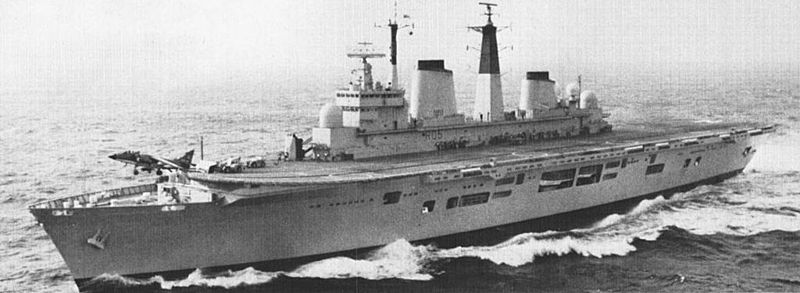
HMS Invincible
This was a herculean task. The Falklands were 8,000 nm from Britain, which translated to 3 weeks steaming. Worse, the nearest base to the islands was Ascension, approximately halfway between the UK and the Falklands. Everything for the campaign had to be aboard before they left - food, fuel, and the thousands of items that make a modern war machine run. As it was, the supply officers responsible for both the ships themselves and the troops who were tasked with liberating the islands (who we will come to in a moment) worked night and day to coordinate the flow of material into the ports. The situation was so desperate that cleanup of the the pile of discarded packing material on the wharves didn't start for two weeks.

HMS Spartan
Of course, the carriers were not the first ships sent south. That honor belongs to the supply ship RFA Fort Austin,4 which was sent to replenish Endurance on the 29th. Ultimately, this would be critical, as the main challenge for the British in the Falklands would be one of logistics. That same day, two days before the invasion, a nuclear submarine was ordered to the South Atlantic, but the worsening situation meant that two of them, Spartan and Splendid, sailed the next day. Eventually, a total of five nuclear submarines5 operated around the Falklands.
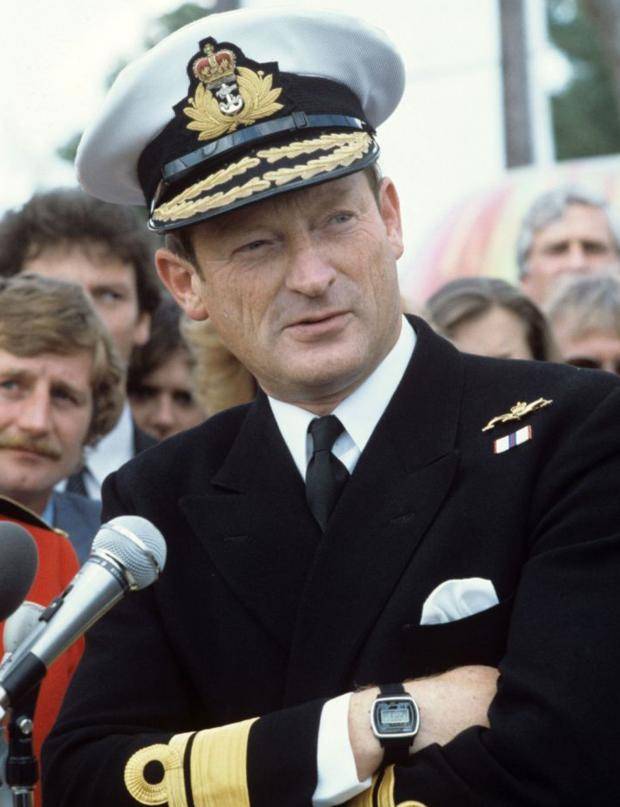
Sandy Woodward
The next wave, which sailed shortly after the fall of Stanley, was built around a group of surface ships that had been exercising in the Mediterranean, destroyers Glamorgan, Antrim, Sheffield, Glasgow, and Coventry and frigates Arrow and Brilliant. They departed Gibraltar after having stripped all available stores and equipment, and even extra personnel, from the dockyard and other ships in the area. This task force, under Rear-Admiral Sandy Woodward, was joined by the tanker RFA Tidespring, and made up the core of the surface escort force at the height of the battle.
Finally, on April 5th, Hermes and Invincible cast off.6 The deck of Hermes, whose island had been cloaked in scaffolding a bare day before, was crowded with Harriers and Sea Kings as she made her way past the cheering spectators. This was not primarily for the spectacle. There was nowhere to put them belowdecks, as the hangar was being used to sort supplies, which had been coming aboard until the gangplanks were withdrawn.
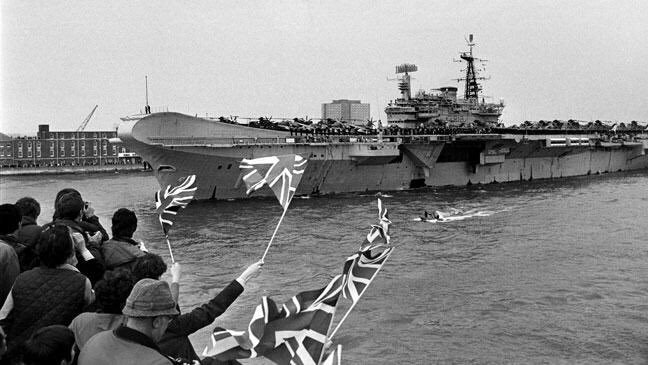
Hermes sailing
Even after they sailed, helicopters continued to shuttle supplies out to the carriers, most notably a replacement starboard main gearbox for Invincible. The one installed had developed a problem shortly after the ships put to sea and had to be changed in the open ocean, something that had never been done or even planned for. This was not the only clever and unexpected improvisation made as the task force headed south. The Sea Harriers, for instance, were modified to dispense chaff by simply placing bundles under their air brakes, then activating them to deploy it.
Of course, naval forces alone would not be enough to liberate the Falklands. The frantic struggle to get the carriers to sea was matched by an equally heroic effort to find land forces and transports for them. The core of the landing force was 3 Commando Brigade, Royal Marines, an amphibious unit usually allocated to Norway in Cold War plans. On April 3rd, it was decided to reinforce it with the addition of 3 Para, a battalion of the Parachute Regiment.7 The steady growth of the landing force meant that the regular amphibious ships, LPDs and LSLs,8 would be unable to carry the force. An order was thus issued giving the government authority to requisition any British-flagged merchant ship necessary for the war. These were referred to as Ships Taken Up From Trade (STUFTs).
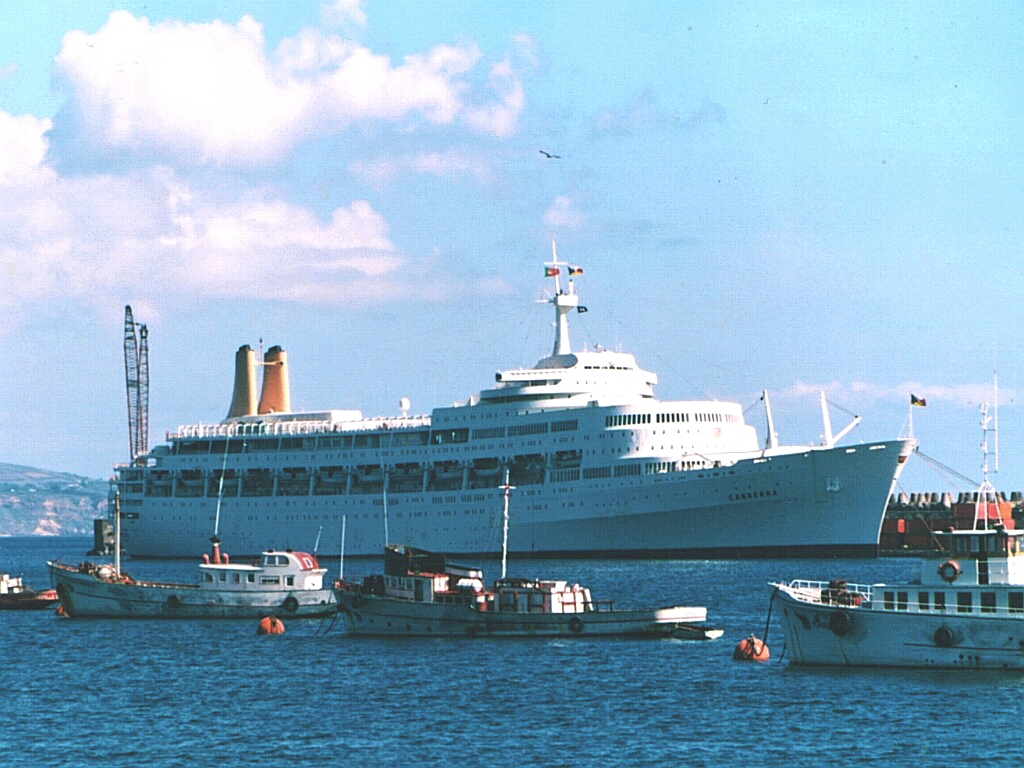
SS Canberra
The first of these was the P&O Liner Canberra, which served as the main troop transport for the initial force. On the 7th, she returned to Southampton from a cruise in the Mediterranean, and was quickly refitted with two helicopter decks9 and improved communications gear, as well as the necessary equipment to refuel at sea. On the 9th, loaded with two Commandos and a battalion of Paras,10 she set sail, jokingly known as a Landing Platform Luxury (Large).
Other ships continued to pour through commercial and naval yards, with Portsmouth Dockyard having at least one STUFT on hand from April 8th through May 21st. Often, design teams would fly out, do a quick inspection, then continue their design work as the ship headed for the chosen yard. Once it reached the yard in question, it was fitted with the necessary equipment as quickly as possible, then sent south. In only a few cases did they spend a double-digit number of days being refitted. Besides the communication and refueling equipment, helicopter pads were necessary to transfer men and supplies in the rough southern waters, and many ferries, designed for the short intra-European routes needed extra fuel and fresh water production equipment. Container ships became aircraft ferries, and North Sea oil rig support boats were turned into repair ships and dispatch vessels to get urgent equipment from Ascension to the Task Force.
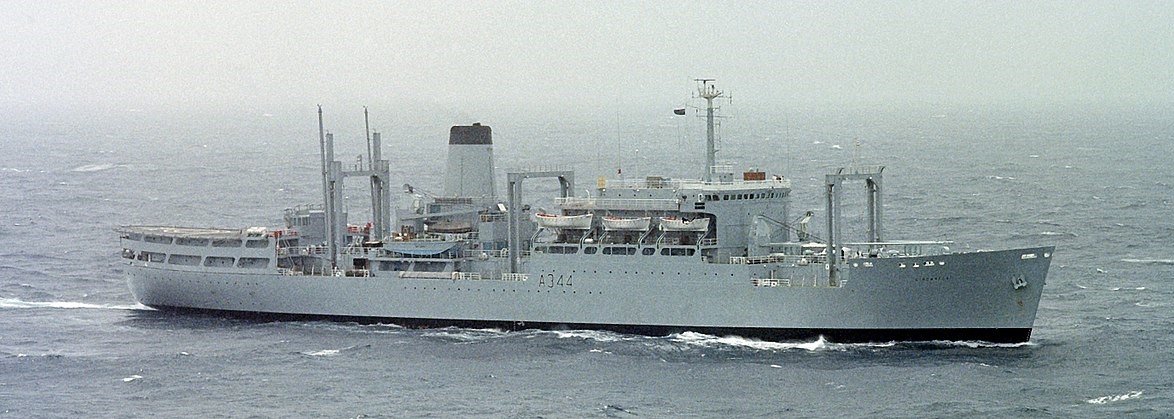
RFA Stromness
The effort of preparing the Task Force, both the regular naval vessels and the STUFTs, is one of the great epics of military logistics. Perhaps the most impressive case is that of RFA Stromness. She had been placed in reserve before the crisis, and on April 2nd, she was in dock, completely destored and with only a care and maintenance crew aboard. On April 7th, she sailed for Ascension, fully stored, with 358 Marines and a month's worth of rations for 7,500 men. Much of this work, particularly at Chatham and Gibraltar, was performed by men who had already received their redundancy notices in preparation for the closure of the yards.
The British forces converged on Ascension, where they would sort themselves out and prepare the way to retake first South Georgia and then later the Falklands themselves. We'll pick up the story there next time.
This post was based off the books The Royal Navy in the Falklands War and Logistics in the Falklands War.
1 I've written a glossary to make it easier to keep track of terms in this series, and the full list of posts is here. ⇑
2 Both, oddly, were slated for disposal under the 1981 defense review. Hermes was to be sold off, while a contract had already been signed to transfer Invincible to Australia. A number of sources take this to mean that Britain was planning to abandon carrier aviation entirely, which is (a) not true and (b) really annoying. Two more units of the Invincible class were under construction, and would have stayed in British service. If you are using this series as a source, please don't make this mistake. ⇑
3 Large dock landing ships ⇑
4 RFA stands for Royal Fleet Auxiliary, a civilian-manned organization which controls most of the RN's tankers, supply ships, and the like. ⇑
5 Conqueror, Courageous and Valiant joined Spartan and Splendid. The non-nuclear HMS Onyx also accompanied the task force, although she was there for inshore special operations work, not sea control. ⇑
6 The first surface ship to leave UK waters for the South Atlantic was actually the tug Typhoon, who sailed the previous day, and wouldn't return until September 24th, well after most of the fleet had made it back. ⇑
7 I have no idea why the British insist on not using suffixes on the unit numbers for their elite formations. ⇑
8 Landing Ship Logistics, basically a modern version of the LST. ⇑
9 It was discovered that empty swimming pools were ideal places for these, as the structure necessary to carry 75-100 tons of water easily bore the loads of a helicopter and deck. ⇑
10 The Marines reportedly got the more luxurious upper cabins by telling the Paras that they'd feel less motion lower in the ship. ⇑

Comments
While looking for more information on the refitting of these civilian ships for the war, I found some archival interviews with Captain DJ Scott-Masson, who commanded the Canberra, where he talks about the refitting and the Canberra's service.
https://www.iwm.org.uk/collections/item/object/80011941
Why were these heroics required? Was the RN in a sorry state in the 80s or was this campaign beyond what if had been designed for?
@Chuck
Neat. I do have another book, Merchant Ships in the Falklands War, that goes into more detail on the civilian side of the retrofits, but which I didn't list in sources for reasons that escape me.
@Johann
The latter. They'd pulled back and focused on ASW with a side of delivering Royal Marines to Norway. Launching a brigade-level invasion 8,000 miles from home was simply not on their radar, so they needed ships to carry the troops. And they just happened to be doing this right on the cusp of a series of major defense cuts. If it had been a year later, they might not have been able to pull it off.
Why "wharves"? As far as I know, that word hasn't been Tolkienized and the correct plural is still "wharfs".
Because I typed it in and my spellcheck didn't flag it. It does flag wharfs. And I don't care enough to argue with it.
Can you elaborate on why didn't British SSN's took a more active role in the conflict? It seems that they had a decisive advantage in technology, intel (some of which could be shared with British by other parties, e.g. USA) and experience and could have easily sunk the whole invading fleet, leaving some stragglers trapped on the islands, which could be handled just with one batallion of paratroopers, which could have been delivered to the place by air.
Afterwards, Brits announce that, say, a 50-mile radius zone around the islands is off-limits to any enemy warships and they will be sunk on sight. Argentine no longer has an ability to move any substantial number of troops to the islands, as their airdrop capability is significantly weaker. That's it, war is technically won.
So why didn't they?
They didn’t get there in time. Note that the first ones didn’t depart the UK until the day before the invasion. Even though they could cruise at 25 kts, that still put them 12 days out when the balloon went up. By the time they got on site, Argentina had most of the defending forces they needed on the islands. There were a few final runs made by merchant ships after the exclusion zone was declared, which were unopposed because the politics of sinking an unarmed and unescorted merchant ship were terrible, and the submarine couldn’t really risk surfacing to warn the ship first. Nor was it politically feasible to just declare open season on Argentine commerce, or even their warships, outside the exclusion zone. They did sink the one major Argentine naval thrust into the exclusion zone, and at that point, the Argentine surface fleet went home and stayed there.
During previous crises around the Falklands, the British had sent SSNs, and announced their presence, presumably, as a deterrent to an invasion. In 1982, things simply ramped up too quickly for them to do that.
It is remarkably difficult, and the stuff of legend, for a submarine to sink enemy warships inside an enemy naval base. One of the first Royal Navy submarines to reach the Falklands, HMS Conqueror, rather quickly found and sunk one of the most powerful warships in the Argentine navy. I'm sure Bean has that story in the queue. But the result was that the Argentine navy decided that, yes, the British SSNs had a decisive advantage in technology and so it would be foolish to challenge them on the high seas. So they didn't.
The invasion fleet didn't identify itself as, and would not have been suspected as, actually being an invasion fleet until it had landed its invasion force. And after that, it was too late - the islands had been invaded and conquered, and it was not Argentine navy warships that would greatly impede Britain's retaking them. All the SSNs could do is force Argentina to shift from supplying and reinforcing their garrison by sea, to doing so by air. Which they did as soon as they arrived.
If we imagine British SSNs actually patrolling the Falklands in peacetime, that probably gets us the interesting scenario of a significant fraction of the Argentine navy hiding in the protected anchorages of the Falklands and afraid to sail home. Which actually would have made it harder for the British.
That's not quite true. The British figured it out about two days before the invasion. The problem was that there wasn't anything they could do. Their only unit in the South Atlantic was Endurance, who had a pair of Wasps with anti-tank missiles. They were 2-3 weeks away by sea, and the Falklands didn't have a runway suitable for high-performance aircraft. They'd sent SSNs to the area during previous crises, and announced their presence as a deterrent. It seems to have worked, too. The problem was that the tensions ratcheted too quickly for them to do that in 1982.